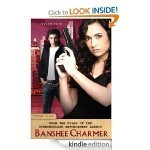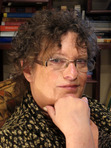The Third Way
It’s always nice for a writing teacher when her students go forth and publish. Tiffany Allee didn’t even wait for class to end. She was in the middle of one of my Next Level courses when she got her first offer of publication. The fact that she sold her work did not come as a surprise (I’d read it), but the speed of her success was startling. One year later, she has three novellas in print and, I believe, a full-length novel in the works.
In this blog, we had several interesting discussions about the merits of trade publishing versus self-publishing. But there is a third way, one that takes advantage of the digital revolution but doesn’t place the whole burden of publishing on the writer, and that’s the way Tiffany Allee chose. I’ll let her tell you about it in today’s guest blog.
From the desk of Tiffany Allee:
During the last few years, writers have argued the merits of commercial versus self-publishing. There are strong lines of division, with (I think) most writers seeing the potential good aspects of both methods.
My road to publication has been a little different. I’m not published with a big New York publisher, although that is definitely something I will be pursuing in the future. But I’m also not self-published. I’ve gone another route, which is to publish with smaller publishers that concentrate on the digital market.
Keep in mind while reading this post that my experience is just that, my experience.
The Beginning
The first writing project I finished (beyond a short story here and there in college classes) was a novel I wrote mainly during NaNoWriMo in 2010. It wasn’t the best novel in the world, but it gave me confidence that I could finish a novel—a first draft of one, anyway. It had a beginning, a middle, and an end. And it all sort of worked together into a fairly cohesive story.
But I knew that before I could fix that story—never mind writing something better—that I really needed to concentrate on important craft skills. Doing that while working on a 90k word novel was daunting. So I decided to write shorter—novellas.
The Problem
Novellas proved to be a wonderful way to learn (and they’re quite addictive). I was able to pick up critique partners to help me even more. I also took a fabulous online workshop with our host here today, Barbara Rogan, that really helped me to build a revision process.
But then, when I had a couple of shiny novellas on my hands, I wasn’t sure what to do with them. Novellas don’t generally sell to traditional publishers, and I wasn’t confident enough in my abilities to self-publish. I needed someone in a professional capacity to agree with me that the works were good enough before I would be willing to put them out there.
After researching digital-focused publishers, and submitting to a few of them, I found homes for my novellas.
But…Do They Edit?
Something I’ve seen touted out there in reference to publishers, especially digital ones, is that they don’t edit. Well, I can say that’s not the experience that I’ve had with any of my publishers.
While the process varies from publisher to publisher, I can speak to what I have seen. I’ve published most of my work through Entangled Publishing, so I’ll focus on my experience with their process here. It is quite similar to what I’ve heard about and seen elsewhere.
Entangled uses what I’ve heard referred to as a three-step editing process, meaning that a book goes through at least three rounds of edits prior to copyediting. Each of these rounds may actually involve more than one exchange of the MS between editor and author, particularly the first round.
Starting with an edit letter detailing content or big picture edits, and ending with line edits, the editing process can be very involved. While an author can push back on some of these suggestions (and I have, on a couple of things here and there), these changes are what bring the story to the next level.
Whew.
And it’s still not done. Then the story goes to the copyeditor. Again back to the author for change approval. Then galleys come out and the author and editor both comb through the story to make sure nothing has slipped through the cracks.
Now that’s a process that would be very difficult to replicate for a self-publishing author. And I suspect that it’s on a level similar to the bigger publishers out there. I don’t know that all digital or small publishers processes are quite so thorough, but that’s one reason why researching the right place to submit to is so important.
At every step in the process, I have never been short of stunned at the level of professionalism I have seen, and the sheer editorial talent that my stories have benefited from.
The Good Stuff
There are definite advantages of going through a smaller publisher, especially one with a digital focus.
Length: Although accepted lengths vary by publisher, they are almost always more lenient than your average NYC house. I’ve seen acceptable ranges from 5k to 120k, and everything in between.
Royalty Rates: Royalty rates with digital publishers tend to be much higher than at NYC publishers, particularly for ebooks.
Timelines: It is feasible for an author to see his or her book published within a year of submission. This isn’t usually possible in the agent to big house route. I will say that wait times on submissions aren’t fast by the definition I would have had prior to learning about the publishing industry, but waiting only a few months on a submission is quick in this world.
Editing, Cover Art, and Marketing: I’m listing these as an advantage, not over a NYC house, but over attempting to self-publish. Cover art is expensive. Good editors are expensive. Marketing is…you guessed it, expensive. And cutting corners in any of these areas is a good way to make sure no one ever hears about your book, let alone reads it.
Promotion: The type of promotion you get varies by publisher, but most excel at guiding their authors on what to do themselves to promote (and it’s a far more complex process than one might think). I have been lucky with Entangled because they provide me with a publicist who helps get my name out there, and who schedules blog tours and promotions for me. I can’t tell you what a timesaver that is.
The Not-So Good Stuff
Advances: Few digital houses offer advances. Most who do offer advances that just aren’t comparable to big houses.
Cover Art and Marketing: Larger commercial publishers may have larger budgets for marketing and cover art.
Distribution: Larger publishers also have distribution networks that not all smaller or digital publishers can compete with. And the importance of shelving books where readers can see them cannot be minimized. It’s huge. (I should also add that some of the larger digital publishers do have excellent distribution in place, and their print lines can be found in bookstores.)
Self-publishing: Pubbing yourself will still offer higher royalties, faster timelines, and even more flexibility with length and genre than a digital publisher. Of course, this comes with a lot of additional cost and risk.
Things to Keep in Mind
Research is your best friend when looking at any publisher or agent. Check online at reputable sites. My favorite site to start researching is the Absolute Write forum. Keep in mind what is important to you in a publisher, and what your expectations are. Talk to other writers. Look at things like sales, publisher reputation, and the backgrounds of the individuals behind the publishing company.
For example, if you want to see your book actually shelved at the Barnes & Noble by your house, you’ll probably want to look at the traditional agent to big publisher route, or to the print lines at Samhain, Entangled, or other smaller publishers whose distribution might make that possible.
While smaller and digital publishers may have higher acceptance rates than some bigger houses, they’re still not easy to break into. Most of the more established ones who sell well have acceptance rates well below five percent. So you still have to make sure to put your best foot forward when querying.
Some genres sell better through digital publishing. There is no question that romance and erotica sell better than other genres, likely in part because some of the pioneers of the digital industry were romance and erotica publishers. But other genres are becoming more common. Publishers like Carina put out all sorts of genres and do not require romantic elements in what they publish. Samhain now has a horror line. Digital publishers of non-romance genres may be more difficult to find, but they are out there.
In Closing…
Digital titles are becoming very popular. My own publisher has had wonderful success, as have others, with multiple titles hitting the New York Times and USA Today lists.
I can say that I am extremely happy. Not only have I learned so much more than I can communicate via a single blog post from my editors and my publicists, but I feel like my stories have only benefited from the brilliant people who I have worked with along the way.
Thanks, Tiffany! I think it’s important to remember that the Big Six are not the only game in town, nor is self-publishing the only alternative. Writers have more choices today than ever before.
Tiffany’s books are very fun reads in the paranormal genre, original and well-written. I hope you’ll give them a read.




